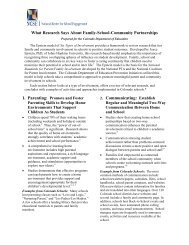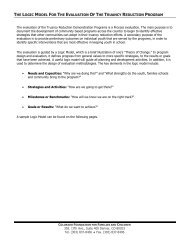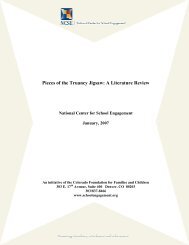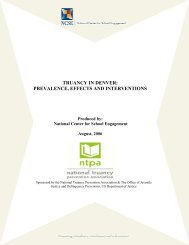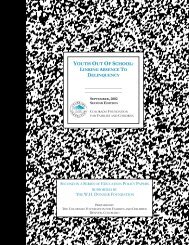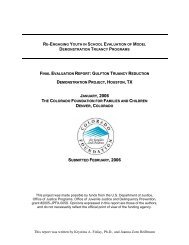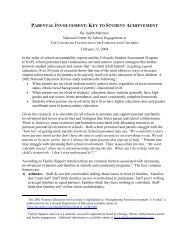Section 1: Academic Achievement - National Center for School ...
Section 1: Academic Achievement - National Center for School ...
Section 1: Academic Achievement - National Center for School ...
You also want an ePaper? Increase the reach of your titles
YUMPU automatically turns print PDFs into web optimized ePapers that Google loves.
As the ELL (English language Learners) teacher at Columbine Elementary <strong>for</strong> the past 11<br />
years I have seen the changes first hand in the school. There are approximately 340 students<br />
in grades 1 st through 4 th . The ethnic breakdown is 65% Hispanic, 45% Anglo. Sixty-five<br />
percent of the students qualify <strong>for</strong> free and reduced lunches. Over 100 of the students are<br />
second language learners and in the 2005-2006 school year, the school averaged 25 Homeless<br />
and Highly Mobile (H&HM) students at any given point during the year. For the sake of this<br />
study highly mobile was defined as two or more changes in school enrollment in the last<br />
calendar year due to economic insecurity, not due to the structure of the school district. The<br />
guidelines of the McKinney-Vento Act were used to identify students as homeless. These<br />
changes in student population are all factors that can spell trouble <strong>for</strong> schools and education.<br />
Columbine Elementary and Fort Morgan are currently experiencing struggles with student<br />
achievement related to the changes in the student population. Hart-Shegos (1999) found that<br />
school-age H&HM students may demonstrate health problems, academic problems and<br />
behavior problems. Rumberger and Larson (1999) determined that mobility was related to<br />
SES (socio-economic status) but not to ethnicity. Mobility was also shown to negatively<br />
impact the classrooms and schools that have large amounts of student mobility including nonmobile<br />
students. This research would suggest a connection between the changes in student<br />
population and the decline of our student achievement.<br />
This Web-Based Professional Development action research project is the second one I have<br />
participated in around the topic of H&HM students. My first project centered around learning<br />
what H&HM students looked like at my school, what resources were available, and using<br />
those resources to keep a HM (highly mobile) student in the same school <strong>for</strong> the majority of<br />
the school year. This time I was a participant in the Web-Based Professional Development<br />
Action Research Project as part of a three-person team. I worked with my principal and an<br />
active community member, who is also a business owner and parent, using the three domain<br />
framework (James, 2004). The domains are 1) Access to educational services; 2) Welcoming<br />
school culture; and 3) Flexible instructional strategies. The community member focused on<br />
the access to educational services. My principal concentrated his ef<strong>for</strong>ts on the welcoming<br />
school culture, and I chose to put my ef<strong>for</strong>ts into the flexible instructional strategies arena.<br />
Action Research to Study Homelessness and High Mobility in <strong>School</strong> Communities 79




